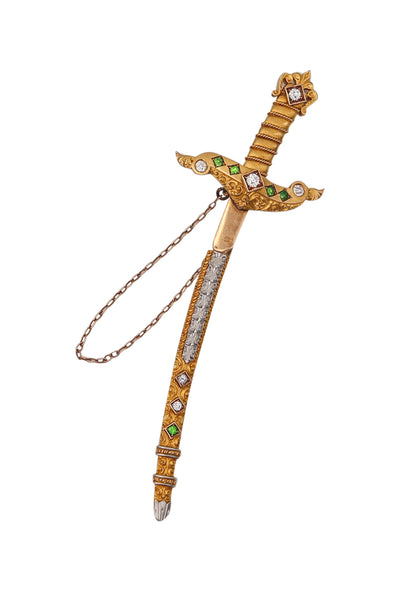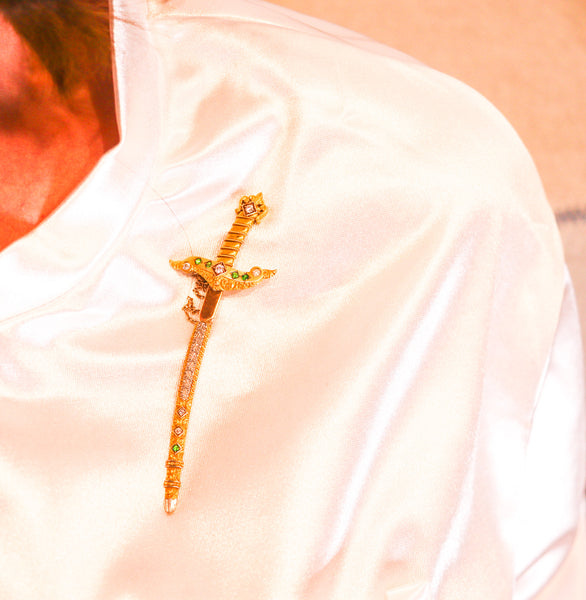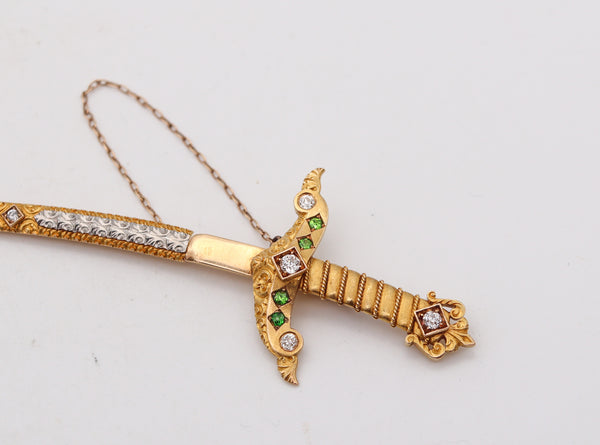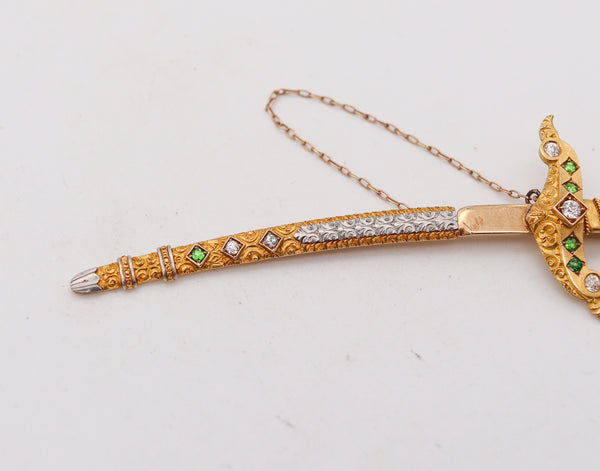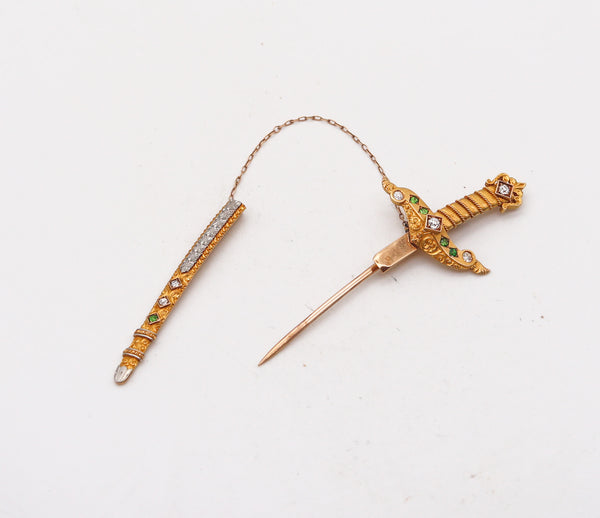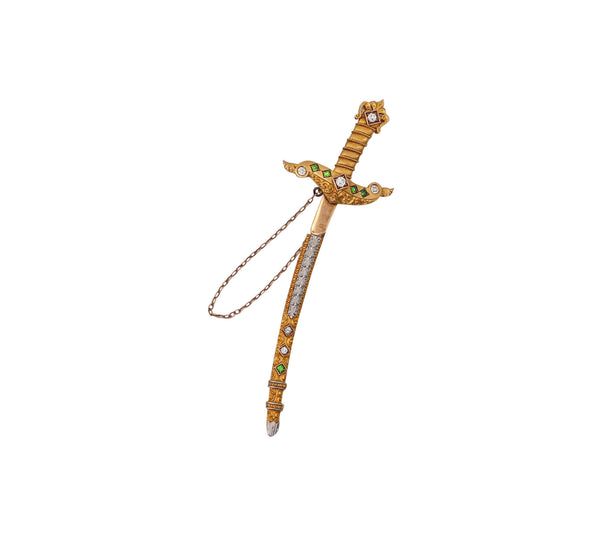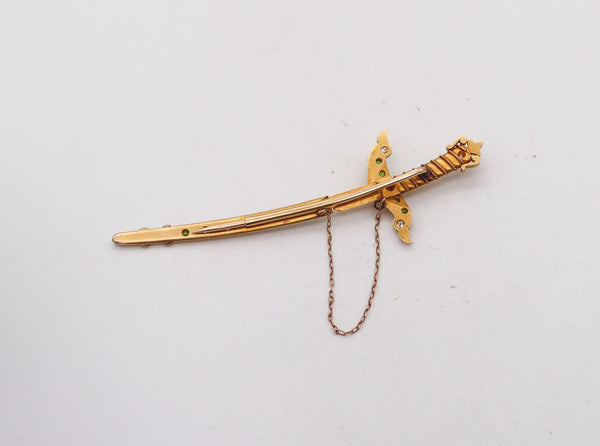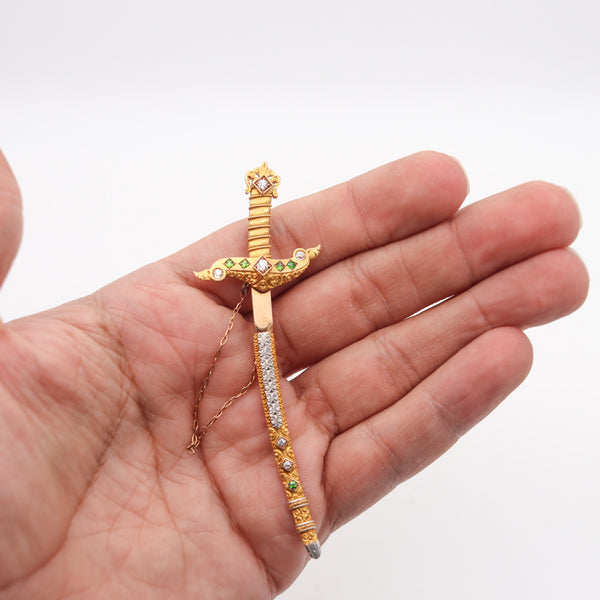-Renaissance Revival 1880 Sword Jabot In 18Kt Gold With Demantoids And Diamonds
Renaissance Revival sword jabot-brooch.
An exceptional and very rare jabot type brooch, created in England during the Victorian era, back in the 1880. This piece is fantastic and has been crafted with renaissance revival patterns in the shape of a miniature sword with jewels, in solid yellow gold of 18 karats with accents in carved platinum. The sword is well proportionate and made with gorgeous details. It is completely decorated with twisted woven wires, engravings and chiseled designs. The sword sheath, the grip pommel and the rain-guard are embellished with a fantastic assortment of eleven natural earth mined gemstones; such white colorless diamonds and vivid green demantoids garnets. It is fitted with a sheath to slide the blade very tight, which is attached to a decorative security chain. This magnificent piece should be an important addition to any serious jewelry collection and will be a great conversation piece when you display it with your dress or on the lapel of your jacket.
Demantoids
Demantoid is the green gemstone variety of the mineral andradite, a member of the garnet group of minerals. Andradite is a calcium- and iron-rich garnet. Ferric iron is the cause of the green in the stone. Although garnets have been known since ancient times, the demantoid variety was not discovered until 1868 in Russia's western central Ural Mountains. The find was an alluvial deposit about 110 km from Ekaterinburg, north by northwest along the Bobrovka River, near the village of Elizavetinskoye. Miners were immediately stunned by the highly refractive nature of the gem material, which is atypical for garnet. They began comparing it to diamond and referred to it as "demantoid", from the old German Demant, meaning diamond. The reason is obvious, with its high brilliance and dispersion. However, as demantoid garnets are quite rare and found in so few locations, they can command quite high prices, especially if they have a particularly lovely horsetail inclusion. Most stones are less than one carat in size after cutting in polishing. Demantoid gems are usually high in clarity but may contain characteristic inclusions of byssolite, needle-like radiating inclusions referred to as “horsetails.” Today, because of limited supplies, demantoid maintains its status as a rare and valuable gem.
Demantoid: Mount in flush French settings, with 5 round faceted cut of natural vivid green demantoid garnets with an estimate total weight of 0.25 carats.
Diamonds: Mounted in a French flush setting, with 6 European rose cut diamonds, with a combined weight of 0.46 carats, F color, VS-2 clarity.
Weight: 12.75 Grams (8.17 Dwt).
Measurements: 97.1 mm by 32.5 mm (3.82 x 1.28 Inches).
Hallmarks: Unmarked, electronically tested for 18kt gold, (.750/.999 Au) and platinum.
The Victorian Jewelry
This era is one of the most influenced and influential periods of antique jewelry. This period is defined by the British monarch, in this case, Alexandrina Victoria, the Queen of the United Kingdom of Great Britain and Ireland, as well as the Empress of India, years 1837-1901. There are 3 sub-periods within this era. First, the early, Romantic period, which is soaked in traditions, natural motifs in gold and silver, clear stones only being worn during the day and colored gems by night. The second being the Grand or mourning period, which coincides with the death of Queen Victoria's husband, Prince Albert the consort, who died in December of 1861. This period included large, dark, somber, dramatic jewelry, with a lot of black onyx, jet wood, amethyst, garnet and gold. This lasted until 1880's, when the aesthetic period of jewelry began. The Late or third stage of the Victorian period, use more complex and feminine motifs, returning to the natural, including many floral and celestial designs, with more decadent gemstones, lasting until the turn of the century. The Victorian era of jewelry includes many movements found in other countries, including revivals such as the Etruscan the Roman and the Egyptian as well as the Art Nouveau, Liberty style and Arts and Crafts design movements which lead into the beginning of the twentieth century.
History Of Revival Jewelry
Between the 1820 and 1890, ancient cities were discovered, such as Troy, Pompeii and Alexandria. Archaeological excavations in Egypt, Greece and Rome, discovered artistic pieces of these ancient cultures. These fabulous discoveries, stimulated cultural trips to these countries, popularly called "grand tour". Being the case that the enthusiast visitors bring back small objects, like souvenirs to be assembled into jewelry. The starting point of these trips were in the cities of Rome and Venice. this is why the craftsmen of these cities created small and interesting objects with ancient characteristics like this piece. The styles from the renaissance and Middle Ages, begun in the 1850’s, The Renaissance and Egyptian revivals were joined by a classical revival of Greek and Etruscan styles to conform a new aesthetic. As a result of the construction work on the Suez Canal in the mid-1860’s and the Egyptian excavations of Auguste Mariette and the resultant exhibit of Egyptian treasures at the exposition Universelle in 1867, a fascination for all things Egyptian and ancient cultures developed.
Collateral: This jabot sword is accompanied by a presentation jewelry box.
Condition: The overall condition of this sword jabot is excellent. Beside the little normal wear, there is no damage to the gold. The gemstones are secured in the settings and all parts are working properly. This piece has been carefully inspected to guarantee the condition and authenticity.
INVENTORY REF: P030925ASAE/.3064









